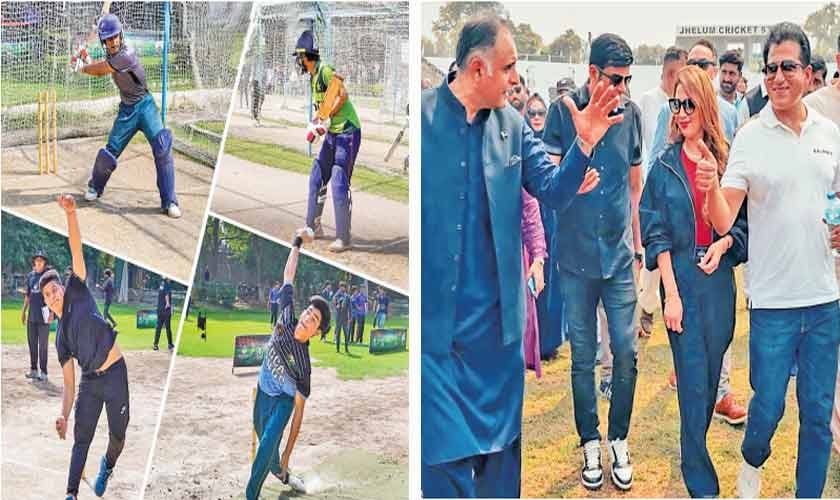When we talk about cricket in Pakistan, we talk about passion, dreams, and an undying love that transcends generations. From the narrow streets of Jhelum to the bustling grounds of Peshawar, cricket is more than just a game — it is a language every child understands.
The Prime Minister Youth Program (PMYP)-Lahore Qalandars Cricket Talent Hunt is giving this passion a direction, a structure, and most importantly, a future. This landmark initiative, led by Lahore Qalandars under the umbrella of PMYP, is no ordinary campaign. It is a national movement aimed at discovering, nurturing, and empowering the next generation of cricketing stars.
Recently, the caravan of talent hunt trials made its way through Khyber Pakhtunkhwa, with stops in Kohat, Abbottabad, and Peshawar. Before that, the energy of Sialkot and Jhelum had already set the stage, proving that our youth are ready to grab opportunities with both hands.
What makes this programme truly special is not just the numbers—though thousands of boys and girls thronged the trials with unmatched energy—it is the intent. These are not random camps or short-lived events; this is a well-thought-out, professionally managed setup, guided by Lahore Qalandars’ experienced coaches and support staff.
The trials have been meticulously designed to provide fair, transparent, and structured opportunities to every participant, regardless of background, city, or resources.
These trials are more than a hunt for fast bowlers, batsmen, or all-rounders. They symbolize hope: hope for a young boy in Kohat who dreams of bowling the fastest ball in the world; hope for a girl in Abbottabad who wants to represent Pakistan on the international stage; and hope for families who believe that cricket can change their destinies.
One cannot overlook the vision behind this initiative. Lahore Qalandars CEO Atif Rana has rightly acknowledged the extraordinary support from Prime Minister Shehbaz Sharif, PMYP Chairman Rana Mashhood Ahmad Khan, and the Higher Education Commission (HEC). Without their commitment, such a massive and inclusive program would not have been possible.
Their combined effort sends out a powerful message: that Pakistan’s youth matter, and their dreams deserve platforms as grand as this.
The recent trials in Kohat, Abbottabad, and Peshawar were nothing short of festivals. Youngsters arrived with their kits, eyes gleaming with ambition, and hearts pounding with excitement. The discipline and determination they displayed were a reminder of the deep cricketing roots in Khyber Pakhtunkhwa.
The same spirit was visible earlier in Sialkot and Jhelum, where the response was equally overwhelming. In fact, the Jhelum trials gained international recognition when US Charge d’Affaires Natalie A. Baker graced the occasion, highlighting the global relevance of such initiatives. Federal Minister Bilal Kiyani’s presence further underlined the government’s commitment.
The beauty of these trials lies in the inclusivity. For the first time in a long while, both boys and girls are given equal opportunities to showcase their skills under professional supervision. This is not only redefining the future of cricket in Pakistan but also challenging long-held stereotypes about women in sports.
The fact that thousands of girls have stepped forward to participate is itself a historic achievement.
For years, we have complained about the lack of grassroots structures, the absence of systematic talent grooming, and the wasted potential in remote areas. Today, through the PMYP-Lahore Qalandars collaboration, we are finally addressing those gaps.
Some of the youngsters in these trials will one day shine on the international stage, just like Shaheen Shah Afridi, Haris Rauf, and other stars unearthed by Lahore Qalandars in the past. The raw talent is already there; it only needs to be polished, guided, and given the right exposure.
The journey, of course, is far from over. The trials will soon move to Swat, Mardan, Muzaffarabad, and Gilgit. If the response so far is any indication, the upcoming stops will see an even greater wave of participation.
This continuity ensures that no corner of Pakistan is left out, and every child with a dream gets a fair chance.
The progress of these trials truly symbolizes a new dawn for Pakistan cricket. This initiative goes far beyond the mere selection of a handful of players; it is about cultivating a culture where raw talent is discovered, nurtured, and celebrated.
It is about instilling in our youth the unshakable belief that with hard work, discipline, and the right opportunities, their dreams can be transformed into reality.
The PMYP-Lahore Qalandars Talent Hunt is, in every sense, a cricketing revolution in motion — a movement that is rewriting the narrative of grassroots development in Pakistan.
With such visionary steps, we can confidently affirm that the future of Pakistan cricket is not only bright and secure but destined to shine with unmatched brilliance.
https://www.thenews.com.pk/tns/detail/1345090-pmyp-qalandars-journey-to-discover-pakistans-future-cricket-stars-continues
